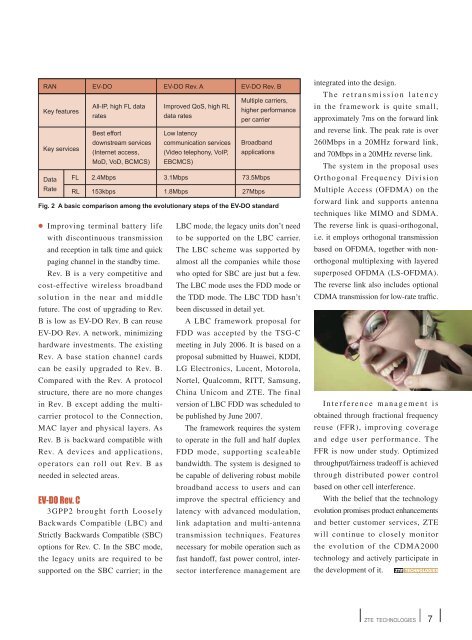PDF download - ZTE
PDF download - ZTE
PDF download - ZTE
- No tags were found...
Create successful ePaper yourself
Turn your PDF publications into a flip-book with our unique Google optimized e-Paper software.
RANKey featuresKey servicesDataRateEV-DOAll-IP, high FL dataratesBest effortdownstream services(Internet access,MoD, VoD, BCMCS)EV-DO Rev. AImproved QoS, high RLdata ratesLow latencycommunication services(Video telephony, VoIP,EBCMCS)EV-DO Rev. BMultiple carriers,higher performanceper carrierBroadbandapplicationsFL 2.4Mbps 3.1Mbps 73.5MbpsRL 153kbps 1.8Mbps 27MbpsFig. 2 A basic comparison among the evolutionary steps of the EV-DO standard● Improving terminal battery lifewith discontinuous transmissionand reception in talk time and quickpaging channel in the standby time.Rev. B is a very competitive andcost-effective wireless broadbandsolution in the near and middlefuture. The cost of upgrading to Rev.B is low as EV-DO Rev. B can reuseEV-DO Rev. A network, minimizinghardware investments. The existingRev. A base station channel cardscan be easily upgraded to Rev. B.Compared with the Rev. A protocolstructure, there are no more changesin Rev. B except adding the multicarrierprotocol to the Connection,MAC layer and physical layers. AsRev. B is backward compatible withRev. A devices and applications,operators can roll out Rev. B asneeded in selected areas.EV-DO Rev. C3GPP2 brought forth LooselyBackwards Compatible (LBC) andStrictly Backwards Compatible (SBC)options for Rev. C. In the SBC mode,the legacy units are required to besupported on the SBC carrier; in theLBC mode, the legacy units don’t needto be supported on the LBC carrier.The LBC scheme was supported byalmost all the companies while thosewho opted for SBC are just but a few.The LBC mode uses the FDD mode orthe TDD mode. The LBC TDD hasn’tbeen discussed in detail yet.A LBC framework proposal forFDD was accepted by the TSG-Cmeeting in July 2006. It is based on aproposal submitted by Huawei, KDDI,LG Electronics, Lucent, Motorola,Nortel, Qualcomm, RITT, Samsung,China Unicom and <strong>ZTE</strong>. The finalversion of LBC FDD was scheduled tobe published by June 2007.The framework requires the systemto operate in the full and half duplexFDD mode, supporting scaleablebandwidth. The system is designed tobe capable of delivering robust mobilebroadband access to users and canimprove the spectral efficiency andlatency with advanced modulation,link adaptation and multi-antennatransmission techniques. Featuresnecessary for mobile operation such asfast handoff, fast power control, intersectorinterference management areintegrated into the design.T h e r e t r a n s m i s s i o n l a t e n c yin the framework is quite small,approximately 7ms on the forward linkand reverse link. The peak rate is over260Mbps in a 20MHz forward link,and 70Mbps in a 20MHz reverse link.The system in the proposal usesOrthogonal Frequency DivisionMultiple Access (OFDMA) on theforward link and supports antennatechniques like MIMO and SDMA.The reverse link is quasi-orthogonal,i.e. it employs orthogonal transmissionbased on OFDMA, together with nonorthogonalmultiplexing with layeredsuperposed OFDMA (LS-OFDMA).The reverse link also includes optionalCDMA transmission for low-rate traffic.I n t e r f e r e n c e m a n a g e m e n t i sobtained through fractional frequencyreuse (FFR), improving coverageand edge user performance. TheFFR is now under study. Optimizedthroughput/fairness tradeoff is achievedthrough distributed power controlbased on other cell interference.With the belief that the technologyevolution promises product enhancementsand better customer services, <strong>ZTE</strong>will continue to closely monitorthe evolution of the CDMA2000technology and actively participate inthe development of it.<strong>ZTE</strong> TECHNOLOGIES57
















